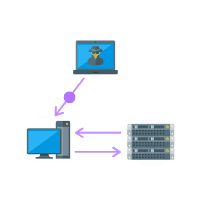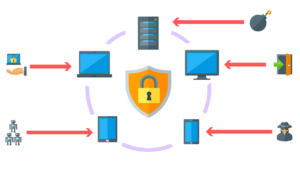A backdoor attack is a breach where hackers install malware that can surpass a network’s standard security requirements to access a system.
You can prevent a back door attack by implementing a solution to detect untrusted software on endpoints, a network monitoring tool, ensuring every device is protected by a host firewall, and using an Anti-virus solution.
Learn More: How To Prevent Cyber Attacks
Free Security Policy Templates
Get a step ahead of your cybersecurity goals with our comprehensive templates.

What Is A Backdoor Attack?

A Backdoor attack is mounted on malware that negates routine authentication procedures to access a system.
As a result, remote access is granted to resources within an application, such as databases and file servers, giving perpetrators the ability to remotely issue system commands and update malware.
Backdoor Installation is achieved by taking advantage of vulnerable components in a web application.
Once installed, detection is difficult as files tend to be highly obfuscated.
Often, Backdoors are used for a number of malicious activities, including:
- Data theft
- Sever Hijacking
- Website defacing
- DDoS attacks
- Advanced persistent threats
The impacts of these actions can be highly detrimental and once access to such a deep and crucial level is obtained, damage possibilities are endless.
Backdoor attacks are typically using malware or using backdoor-specific software/hardware.
Why Backdoors Are Dangerous
Backdoor malware has the ability to seamlessly go undetected as it pretends to be something else. Its behavioral abilities consist of threats like worms.
This allows this malware to become competent to replicate and expand to other systems as well.
Other Backdoor attacks are rooted in built-in backdoors that software developers create to gain instant access to the application/software in order to patch and fix software bugs.
The Threat Of Backdoors
Backdoors present a lot of complicated problems for application users because most of them are designed to go undetected.
Unknowing you may have acquired software that grants adversaries access to your PC or device.
According to Statista, the most commonly encountered type of malware attack worldwide are backdoor attacks accounting for 37% of all detected attacks.
Example Of A Backdoor Attack
Solarwinds is a well-known example of a backdoor attack.
In this, hackers used malware that created a backdoor to customers’ information technology systems. Hackers then used this to install even more malware that helped spy and steal data.
The SolarWinds attack exposed 18,000 clients after they downloaded and installed tainted software. The attack was reportedly carried out by The Russian Foreign Intelligence Service.
The breach was first detected by a cyber security company that identified the backdoor used to gain access to SolarWinds systems.
SolarWinds has committed over $90 million in relief funds to absolve this, making it one of the most significant cyber security attacks ever.
How Do You Prevent Backdoor Attacks?
A few security actions you can take to prevent a backdoor include:
- Use An Antivirus Solution: Deploy advanced antivirus software that can detect and prevent a wide range of malware, including trojans, cryptojackers, spyware, and rootkits.
- Implement Network Monitoring: Set up a network monitoring tool to keep an eye on network traffic. This helps identify any suspicious or unauthorized activity, including potential backdoor access.
- Detect Untrusted Software On Endpoints: Implement a solution that scans for untrusted software on your devices. This ensures that any unauthorized or potentially harmful applications are promptly detected and addressed.
- Host Firewall Protection: Ensure that every device is protected by a host firewall. Firewalls act as a barrier between your internal network and external threats, preventing unauthorized access.
Article by




